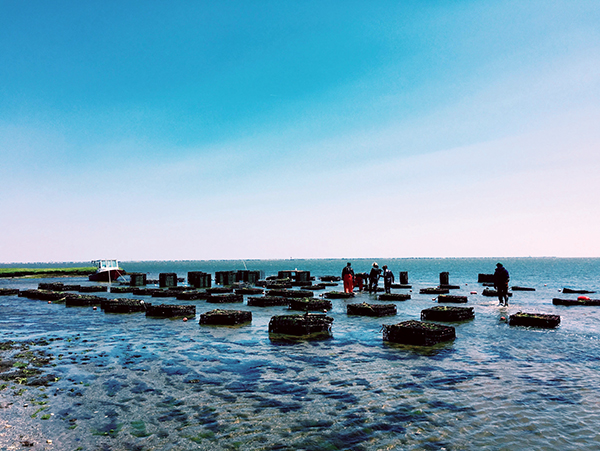Shelling Out
by Emily Kovach
The first rays of sunshine are peeking over Barnegat Bay in coastal New Jersey when Matt Gregg, 33, steers his boat out into the water. The cool air of early dawn isn’t tempered yet by the summer heat, and Gregg and one of his employees are headed out to harvest some of the oysters that have been growing on Gregg’s property, Forty North Oyster Farms, for between 18 and 24 months. Now that they’re considered market size, they’ll be sorted, counted and bagged, then taken back to a refrigerated van waiting on the dock. This is the twice-weekly summertime ritual that allows Gregg to finally share his oysters with chefs and other culinary-minded customers, after raising the baby bivalves since they were barely the size of quarters.
Gregg is a New Jersey native who followed his passion for sea life to the University of Rhode Island, where he majored in aquaculture. After graduation in 2006, he pursued a different passion—music—to New York City, where he worked for a competitive talent agency. After a few years, though, he began to feel pulled back to the water. He’d worked on fishing boats during summers in college and had always been intrigued with oyster farming, so he decided to see if it was an industry he could break into.
He wanted to operate his new venture close to his hometown, but acquiring land proved to be a herculean exercise in maneuvering through layers of bureaucracy. Gregg sighs as he remembers the arduous process.
“There’s no system in New Jersey that allows an individual who would be well-suited to working in the water to get through the process,” he says. “There’s a lot of regulations, permits and licensing, and I just started digging into it.” Gregg had also studied marine and coastal policy in college, and his existing familiarity with these sorts of laws helped guide him through
the red tape.
In 2011, Forty North Oyster Farms opened on a 6-acre plot of land. The moment was not just an important milestone in terms of Gregg’s career, but for the New Jersey oyster-farming community as a whole. While the wild oyster industry on the Atlantic Coast of the state was a viable, thriving industry in the beginning of the 20th century, it collapsed in the 1950s due to pollution, oyster disease and overharvesting.
“I’m pretty sure we were the first ones to harvest a Barnegat oyster in 50 years,” Gregg says.
Forty North started small, with 40 cages, a little boat and 200,000 oysters. Now, it produces about 1 million oysters each year. Gregg works with hatcheries and does his own research to develop the best oysters possible for his growing conditions.
“We take adult oysters, spawn them in a controlled setting and look at their genetics,” he says. “Just like anything you’re breeding, you want the fastest and strongest growing you can find.”
His main oyster is called the Rose Cove (named after their location). Because their plot of coastline is exposed to the south, every afternoon in the summer the south wind kicks up waves that sweep in and tumble the oysters in their cages. This results in supersmooth shells with deep cups. The oysters themselves have a nice salinity, due to the clean ocean water coming in from just a few miles away. But what Gregg credits most with helping his oysters thrive is that his farm is surrounded by thousands of acres of undeveloped sea meadows, with freshwater ponds and sea grasses, whose nutrients run off into the bay during rain storms.
Oysters only grow when the water is over 50 degrees, which results in a six-month growing season in New Jersey. During those months, and in the off-season, Gregg focuses the rest of his energies on sales and marketing. When he’d first begun oyster farming, he reached out to local seafood wholesalers and got lukewarm responses, even though chefs were frequently asking him for his oysters. Even though becoming certified as a wholesaler was another huge exercise in licensing and regulation compliance, Gregg ultimately decided to go for it. “It would be a lot easier to be an oyster farmer and put my oysters on a truck and not think about that,” he says. “But we had so much demand locally.”
In early 2017, to help offset some of the costs of wholesaling, Gregg and his friend Scott Lennox, another oyster farmer, founded the Barnegat Oyster Collective and reached out to seven other oyster harvesters in the area. So far, the collective is selling 60,000 oysters each month (a number that will double in the summer) to 50 restaurants.
After six years in the business, Gregg says he’s confident that oyster farming is his lifelong career.
“You grow up and people tell you to follow your dreams,” he says. “I don’t know if that’s actually great advice, but for me, I got lucky.”



